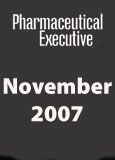FDA's Approvable Problem
Pharmaceutical Executive
Approvable letters delay NDAs, cost pharma plenty, and are at an all-time high. Industry says FDA is gun-shy; the agency says it's business as usual. Who's right?
They scuttle product launches and send company stocks through the floor. They steal precious years from patents and require pricey new trials. They have the entire drug industry on edge, from struggling one-hit biotechs to struggling large-cap pharmas. They're FDA approvable letters—that odd regulatory response that isn't quite an approval and isn't quite a rejection—and in the past three or four years, they've become a major part of the FDA's arsenal for dealing with (or, as many say, not dealing with) new drug applications (NDAs).
As of October 1, the agency had already issued 23 approvable letters this year, including second letters for four drugs and a third for one. After hearing industry insiders grumble that a scared-safe FDA was upping the letter's use, Chris Milne of the Tufts Center for Drug Development looked into the issue in 2005 and counted 35 approvable letters for NDAs between 2001 and 2004, causing an average delay until approval of 20 months. FDA has issued 36 such letters since January 2006 alone.
So Approvability Gulch is a real place. The question is, what does the trend mean? Has FDA quietly raised its safety standards, as many people argue? Or is it using the letters to simply avoid approving drugs—waiting for the current political storms to settle? And if there is a new safety order, what are the potential risks for both the industry and the agency?
The Regulatory Creep of 'Basically Approvable'
Here's how the Code of Federal Regulations defines approvable letters: "In selected circumstances, it is useful at the end of the review period for the Food and Drug Administration to indicate to the applicant that the application or abbreviated application is basically approvable, providing certain issues are resolved. An approvable letter may be issued in such circumstances.... As a practical matter, the approvable letter will serve in most instances as a mechanism for resolving outstanding issues on drugs that are about to be approved and marketed."

John Jenkins, FDA
That may sound benign, but in the post-Vioxx real world, "resolving" an "issue" can lead a drugmaker off a cliff. Some "approvable" drugs are hardly on the verge of approval:
- In 2005, Bristol-Myers Squibb killed its diabetes drug, Pargluva (muraglitazar), saying that it would take five years to gather data about cardio risks flagged by FDA. (The company may also have believed that additional data would sink Pargluva, a PPAR-antagonist like GlaxoSmithKline's Avandia, which was almost withdrawn this year because of its heart-attack risk.)
- Sanofi-Aventis' novel obesity treatment, Acomplia (rimonabant), marketed in Europe, received an approvable letter from FDA in 2006. After submitting the FDA-requested data, the French firm got an unfavorable review from an FDA advisory committee in June and withdrew its NDA. Unlike BMS, Sanofi is standing by its much-vaunted drug and plans to submit a new NDA for diabetes. But the ETA is 2010, at best.
- Novartis' Galvus (vildagliptin), its diabetes blockbuster-to-be, which was already on the market in Europe, received an approvable letter in February. The additional clinical trials are expected to postpone Galvus' launch until 2009, putting the DPP4-inhibitor hopelessly behind Merck's first-in-class Januvia, which started the race with a mere three months' advantage. This has cost Novartis at least $500 million in unmet projections and left its new U.S. rep army with little to sell.
Novartis CEO Dan Vasella, virtually the only pharma CEO willing to speak openly on the subject, has his take on the trend. "The FDA has become subject to politics," he told the Financial Times in September.
Analyst Steve Brozak, president of WBB Securities, agrees. "It's to the point where it's by exception—not the rule—that drugs are approved," he said, and then raised another red flag: "Innovation and safety are contraindicated. Pharma can't have blockbusters in very large populations at the same time FDA has no safety signals."
In a study released in August, James Kumpel, an analyst at Friedman, Billings, Ramsey, reported that FDA OK'd 38 new drugs between January and July, down 31 percent from 55 approvals for the same period in 2006. Meantime, the number of new molecular entities (NMEs) is at a 10-year low, seven through July, compared with an average of 12 over the same period every year since 1998. "They've raised the bar," said Kumpel, whose study helped spark a recent media flap about the drug-approval slowdown. "They've made it more difficult for drugs to get through the system."
It doesn't take a scientist or analyst, however, to detect that different drugs are being treated differently in FDA's decisions:

Gretchen Dieck, Pfizer
Big-market drugs Innovative drugs for common chronic conditions that will be used by millions of people are getting scrupulous scrutiny—particularly for heart and liver toxicity—and are routinely found wanting. The message seems clear: No more Vioxxs! As a result, pharma has had to sit on its hands as one after another potential top-seller gets jettisoned.
Me-too drugs These seem to be hit hardest of all. In 2005, only one of 14 me-too drugs won approval on the first try—another 10-year low. The poster child for these drugs is Merck's Vioxx spinoff, Arcoxia (etoricoxib), which didn't even earn an approvable letter. To many observers, FDA's new unofficial policy seems to be that me-too drugs don't just have to prove safety and efficacy—they have to prove superiority to existing drugs. "The discussion on what this [drug] brings over and above what's on the market is a question that's being asked," Vasella told the Financial Times. "FDA doesn't seem to trust the physicians any more."
Second indications Given that these drugs are already in wide use, their safety profile should present fewer uncertainties. But the agency asked to see more data for Wyeth's Pristiq (desvenlafaxine) and Endo's Frova (frovatriptan succinate), both for menopause; Encysive's Thelin (sitaxsentan), for hypertension; and Trexima (naproxen and sumatriptan), a new combination being codeveloped for migraine by Glaxo and little biotech Pozen, whose stock value dove by half at the news. The NASDAQ Biotechnology Index is down about 14 percent since last winter, a drop some analysts attribute to investor skittishness about the FDA's abundance of caution.
Priority NDAs FDA has seemed careful not to put the brakes on approvals for important drugs for life-threatening diseases; each gets not only a speedy six-month review but its own risk/benefit ratio. In oncology, for example, Pfizer's TKE inhibitor, Sutent, became the first drug ever approved for two indications at its first time at bat. First-in-class cancer drugs that sailed through include Wyeth's mTOR (mammalian target of rapamycin) inhibitor, Torisel, and Glaxo's first small-molecule ERB1/2 inhibitor, Tykerb. Yet with oncology pipelines exploding, the gate may be closing. According to Tuft's Chris Milne, the agency has delayed (or rejected) five promising cancer therapies since January, including Genetech's Avastin (bevacizumab) for its third indication, breast cancer. Another NDA was blocked on dubious grounds, Milne says: "FDA told the company it doubted the postmarketing studies were going to be done on time and demanded the firm do them before approval. But, in fact, 89 percent of postmarketing studies in oncology meet their deadlines." And since such studies can take five to 10 years, the drug was DOA.
Still, not everyone inside pharma sees a conspiracy, or even a controversy, in the new wave of approvable letters. Gretchen Dieck, vice president of safety and risk management at Pfizer, said that to make a fair assessment, you'd have to examine each NDA on its own terms. "The drug development process is long—and not a straight line," Dieck said. "Something can come up, such as new side effects with a class of drugs or new surrogate markers, and the agency will say, 'You need to address this in your clinical trial.' It's not necessarily a matter of negligence on the part of the drugmaker."
Safety, Politics, or Both?
The explanation most often heard for the spike in approvable letters is the obvious one: that FDA has raised the bar for drug safety. This takes account of both the scientific and the political aspects of the issue. Most letters ask for additional data either about a specific "safety signal" or about more general heart and liver toxicity. At the same time, the agency is seen as desperate to rehabilitate its image as a guardian of public health—and, ironically, "above" politics.

Mark Senak, Blogger
"Vioxx and other episodes shook confidence in the agency, and took it from being a gold standard to having a very tarnished image," said Mark Senak, senior vice president at Fleishman-Hillard and EyeonFDA.com blogger. But Senak also points to other factors that likely play a role. "Coinciding with that was the fact that for the past six years, FDA has been rudderless at the top," with a series of short-lived or interim heads until Andrew von Eschenbach's confirmation last spring.
Nor has drug-safety been the only area in which politics has appeared to intervene, Senak point out. The typically hush-hush process of drug approval burst wide open in 2004 during the machinations around the review of Plan B as an over-the-counter "morning after" pill. The acting director of the Center for Drug Evaluation and Review (CDER) sent it back, asking for more safety data related to its use by teenage girls—a decision widely viewed as a sop to President Bush's abstinence-only fundamentalist base. The ensuing protests from scientists both inside and outside FDA raised still-unanswered questions about the degree to which the agency is influenced by the administration's own political agenda.
"Congress began scrutinizing the internal process at FDA," said Senak, "and it saw a lot of things it did not like. Enforcement of regulations was down. People who were not experts but political appointees were inserted into advisory committees. There was a wave of whistle-blowers and a general degradation of morale."
There has been a prolonged and unprecedented public airing of internal disagreements about drug approval, with the drug-safety camp in open strife with the drug-review camp. "The agency has been called out on this by Congress. There have been specific charges that it suppresses safety information, or at least dissent," said attorney Daniel Kracov, head of Arnold & Porter's pharmaceutical practice. "It is a very difficult atmosphere to make tough decisions about drug safety, and this may induce too much caution on FDA's part."
Still, neither Senak nor Kracov believes that there has been a single order from on high to turn the ship around on safety. Speaking for FDA, Dr. John Jenkins, who has headed the Office of New Drugs at CDER since 2002, says there has not been. He emphasizes that each NDA is evaluated individually, and the agency doesn't set a target for how many drugs will be approved each year. Yet he acknowledged that public concerns over drug safety have had an effect. "The calls for having more certainty about safety than may have been required in the past are in the minds of decision makers when reviewing drugs," he said.
To Jenkins, the conventional wisdom on approvable letters gets the story backward. "It's probably true that we have been issuing more approvable letters recently, but in most cases that is a shift from what would have gotten a nonapprovable letter before," he said. If anything, "approvable" status means the drugmaker doesn't have to submit a whole new application, a bonus for pharma.
"In some cases, companies are looking for convenient explanations for not getting their applications approved," Jenkins added.
Jenkins can be forgiven for sounding a little gruff. The controversy over approvable letters has emerged on the heels of months of public excoriation of FDA's safety-monitoring failures and debate on how to "reform" the agency. Suddenly the media were painting FDA as an agency too browbeaten to approve drugs. Needless to say, these articles didn't carry headlines like "Newly Safety-Conscious FDA Stands Up to Industry Ire." Interestingly, of the 12 or so NDAs approved since late August, as the "slowdown" controversy gain traction, only one got an approvable letter.
A New Fulcrum for the Seesaw
But what about the accusation that FDA is basing decisions on politics not science? Jenkins framed his answer carefully. "We at FDA reflect the approval standards that we hear from Congress and the public. We can set the bar wherever they tell us to, though the pros and cons of any change must be carefully weighed," he said. "And some people would say that to do otherwise would be irresponsible of us."

Steve Brozak, Analyst
In other words, it's true—a new, more cautious mind-set has taken hold at FDA, and given the chances of a Democratic presidential victory in '08, it's no temporary trend. "I would not be surprised if the decisions we make now are different from decisions we would make in the past when looking at the same set of data," Jenkins said.
Jenkins may not be surprised, but drugmakers are—or claim to be. A recent First Albany Capital report notes that "the FDA's tolerance of [safety signals] appears to have declined," resulting in "unsettling surprises."
"I can't believe they weren't anticipating that things were going to get tougher," said Chris Milne. "But knowing things were going to get tougher and dealing with it are two different things."
In the first place, it's common knowledge that the speed with which FDA approves drugs goes in cycles. The regulatory barriers to approval move like a pendulum, rising and falling based on pressure from Congress, advocates, and, yes, even industry. "There is no constant, quantifiable bar for either safety or efficacy," said Ken Kaitlin, who heads the Tufts Center for the Study of Drug Development. "Where FDA puts the balance between the two is really a public decision."
That's why Kaitlin believes that this is a "he said, she said" in which both pharma and FDA are right. "FDA's standpoint is that it's doing the same thing it has always done—but just using a new fulcrum for the seesaw," said Kaitlin. "But from pharma's side, FDA has indeed raised the bar because now a drug needs to show a lot more weight in efficacy to offset the risks."
Chris Milne dates the swing toward safety to the agency's recall of Warner-Lambert diabetes drug Rezulin in 2000 due to liver fatalities—a debacle that featured both incompetence (three label changes) and intrigue (studies that the safety office kept secret from the rest of the agency). "After that, FDA did a self-analysis and instituted some changes to the way they review submission packages," said Milne. "So drugmakers may have been able to predict that this was all going to happen."
And far from being caught unawares, said Russ Somma, president of SommaTech, some companies may even be angling for an approvable letter—rather than withdrawing what they know is a flawed NDA. "It certainly looks better to stockholders," he said. And at certain large-cap pharmas, he explained, there's an unwritten policy not to yield to any FDA demand, turning the approval process into a game of Uncle.
The Carrot-and-Stick Approach
Let's not overlook the possibility that FDA is using approvable letters to push pharma to get with the program. Although Jenkins did not mention it, FDA officials have complained that the quality of recent NDAs has fallen off. "There's probably some truth to that," said APCO Worldwide's Wayne Pines. "Drugmakers feel enormous pressure to get applications to FDA as fast as possible. Some are submitting packages that don't have sufficient pivotal data, even at the risk of having FDA reject it and ask for more."
There are plentiful signs that the frustration pharma feels about FDA is returned by the agency. According to Somma, it's less the NDAs than the high number of postapproval filings that are clogging the system and causing the approvable letters. "Companies are not always being up front about their business plan for a new drug," he said. "They come in a month after approval with a shopping list of changes they want to make rather than building this into the NDA. And FDA has to manage all of this, too, so the approvable letters are a way to deal with this increasing workload." In fact, the agency's chronically understaffed, overcommitted condition is a cause for considerable alarm inside FDA and pharma alike.
The agency may be drawing a line in the sand about the quality not only of safety and other data but of its relationship with pharma. "FDA has been sending a few important messages," said Somma. "It wants industry to sign onto its Quality by Design and 21st-Century initiatives. But it also wants transparency and honesty. More and more, FDA looks at NDAs and says, 'Is that all there is? You guys have spent 12 years and a billion dollars to make this drug and this is all the data you have?'"
The heart of the drug-review process is, after all, a power struggle over access to information. "Legally, FDA can demand to look at every single piece of data," said Somma. "If they trust a company, they won't do that, but if you try to pull the wool over their eyes with the magic of your technology, say, or simply by hiding data, they're going to give you a hard time"—in the form of an unapprovable letter.
Ultimately, the message FDA is sending to industry is "work with us, not against us." An agency-funded study in 2005 by Booz Allen found that the more meetings a firm has with FDA about an NDA, the better its chances of getting its application approved. And Chris Milne points out that not a single fast-track or orphan drug, which are developed with maximum pharma–FDA teaming up, has ever been withdrawn from market. Yet for pharma, such close collaboration too often adds time and cost to the process without increasing the quality of the data. Certain safety signals will materialize only when a drug is on the market and in wide use—no matter how many Phase III trials are run.
In addition to costs of one kind of another, it may also come down to a question of trust, or the lack thereof. Both Big Pharma and FDA have, fairly or not, suffered a serious loss in public trust in recent years, and both remain under enormous stress. Given the current political climate, it's not clear what option FDA has other than to push back against pharma on issues like safety and transparency. It will be up to each drugmaker to decide how to respond. Yet the fact remains that the fortunes of Big Pharma and FDA are tied to each other, and rise and fall together.
Fortunately, there's cause for optimism. "FDA is reaching out to pharma on a regular basis, asking for more open interactions," Russ Somma said. "And a number of companies have gotten together to work with the agency on different issues," such as the consortia for biomarker R&D in cancer, cardiovascular disease.
Unrealistic Hopes, Unintended Consequences
Yet whether the new safety regime will—or even can—produce safer drugs remains to be seen. Many people inside pharma, including scientists, argue that the status quo doesn't need fixing. "In the vast majority of cases, when we find adverse events after approval, the benefit/risk ratio of the drug doesn't change. That means the system is working," Pfizer's Gretchen Dieck said. "In a very few cases, like Vioxx, it does change—but then everyone throws up their hands and says, FDA is broken!"
Tuft's Chris Milne marshals statistics to back Dieck up. "Withdrawals of drugs happen in a cluster—every three to five years," he said. "But the actual rate of withdrawals is consistent over time at 3 percent." In other words, faster drug approvals seem not to result in riskier drugs.
Likewise, there's considerable skepticism over whether the safety profile of drugs can be significantly improved—pending the advent of disease markers and personalized medicine. What needs fixing, from this point of view, is the uninformed—and, therefore, unrealistic—expectations of us consumers, not to mention our politicians.
"We need to do a better job as a society in communicating that just because a drug is FDA approved doesn't mean it is totally safe," said FDA's Jenkins. "What people really have to be thinking about is, What is an acceptable risk for the real benefits?" In that light, it's ironic that the prolonged post-Vioxx public drubbing of pharma and FDA may have only further raised false hopes about drug safety.
"You had congressmen who know little about safety or the drug approval process second-guessing FDA and proposing legislation for FDA," Dieck said.
The main thrust of PDUFA IV, of course, is to beef up safety monitoring without slowing down approvals. The legislation gives FDA more muscle to hold drugmakers accountable for better—or, at least, more extensive—data collection and reporting before and after approval. To the extent that it formalizes the demands for increased detection of safety signals that are currently resulting in approvable letters, PDUFA will, at the very least, likely remove the element of surprise from the process, limiting the disruption of launches, and, projections.
It may be too much to hope for that the PDUFA safety reforms will serve to restore public trust in FDA—and, by extension, Big Pharma, which strongly and visibly supported the legislation. Recent polls suggest that the tide has turned and public opinion is growing more favorable. But many people interviewed for this article voiced fears about how the agency will fare when—not if—the next Vioxx happens.
"The increased burdens on FDA require much greater resources to implement properly," said APCO Worldwide's Wayne Pines. "Congress holds the agency responsible, and if it doesn't get more money, it may not be able to meet expectations—and that could have very troubling consequences." Pines is president of the new nonprofit FDA Alliance, which is lobbying Congress to adequately fund the agency to the tune of $2 billion. (For more information, see http://www.strengthenfda.org/.)
Given that several influential congressmen are advocating something very much like tearing FDA down and starting over, the troubling consequences aren't hard to imagine. But even without another Vioxx, politics will always intrude. Next year's presidential election escalates the sense of uncertainty about the agency's agenda—and whether the pendulum will keep moving toward drug safety or begin tacking in the direction of speedier approvals.
There are other kinds of politics at play too. "At the same time that people are criticizing us about approving drugs too fast," FDA's Jenkins said, "we have a lawsuit being filed against the agency saying that patients should have access to drugs sooner."
In July, after FDA issued an approvable letter to Dendreon for its prostate cancer drug, Provenge (sipuleucel-Tg), asking for more data, the cancer activist group Care to Live went to court. By September, 200 men age 50 and older were marching, with their wives and other supporters, on the agency's headquarters in Rockville, MD. They chanted, waved placards, and acted, most uncharacteristically, like angry young protestors. Their signs read: "Approve Lifesaving Drugs Now" and "FDA: Federal Dinosaur Agency."

Navigating Distrust: Pharma in the Age of Social Media
February 18th 2025Ian Baer, Founder and CEO of Sooth, discusses how the growing distrust in social media will impact industry marketing strategies and the relationships between pharmaceutical companies and the patients they aim to serve. He also explains dark social, how to combat misinformation, closing the trust gap, and more.
Pfizer, GSK Gain ACIP Recommendations for RSV and Meningococcal Vaccines
April 18th 2025The Centers for Disease Control and Prevention’s Advisory Committee on Immunization Practices voted to expand access to Pfizer’s respiratory syncytial virus vaccine Abrysvo for high-risk adults in their 50s and voted in favor of GSK’s meningococcal vaccine, Penmenvy, for streamlined adolescent protection.